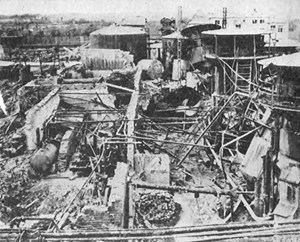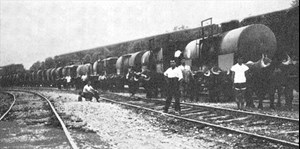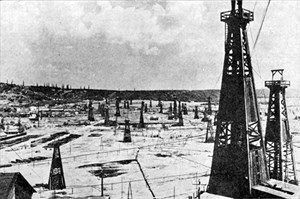Operation Tidal Wave: Targeting the source of Germany’s oil supply
At the height of World War II, oil supply was a concern for everyone involved, including Germany. Until this time, The Oil Weekly had dedicated only small sections of the publication to international reporting, keeping the majority of its focus on industry developments in the U.S. However, it was during this time that the editors began to broaden the scope of the book’s coverage, and more attention was given to progress overseas.
Because Romania was the largest oil producer in Europe at that time, it was reported as early as the March 18, 1940, edition of The Oil Weekly, that the country could potentially be invaded by the Germans, who desired to take possession of Romania’s oil.
In the Feb. 24, 1941, edition of The Oil Weekly, Ray Dudley, himself, devoted two pages to an in-depth look at the situation regarding Germany’s oil supply. His report, “Germany’s Oil Supply: Apparently Adequate For Her Needs,” addressed rumors of a possible shortage of gasoline and lubricating oils.
The article concluded that Germany was experiencing no shortage of petroleum products. In fact, in addition to its own synthetic plants making fuel, the country was receiving oil supplies from surrounding countries, including Romania, Austria, Poland, France, Hungary and even Russia.
Information provided in the article indicated that there was a wide divergence of opinion as to the amount of crude and petroleum products captured by the Germans, when they overran the Low Countries and France. However, rumor was, that it was as high as 50 MMbbl. Dudley, however, set the record straight by citing the actual amount at 10 MMbbl to 12 MMbbl.

The seizure of Romanian oil fields in late 1940 had solved many of Germany’s supply problems, making it a pivotal part of the country’s war effort. Ploieşti, Romania, expressly was surrounded by refineries that produced upwards of 60% of the fuel for the German war machine, which naturally made it a target for Allied leaders. Consequently, the area was the second most heavily defended target in Europe, after Berlin.
In April 1943, the U.S. Army Air Forces were given orders to revive the already-developed plans for an attack on the Ploieşti oil fields. The plan was to implement a massive low-altitude attack, launched from Benghazi, Libya. The strategy was given the code name, Operation Tidal Wave.
On Aug. 1, 1943, American bombers executed the attack on the oil fields. Unaware of the true scale of the defenses surrounding the refineries, the attack was ineffective. The Soviet Air Force also made several attempts to bomb the refineries, but was not very successful.
U.S. Strategic Air Forces, an arm of the U.S. Army Air Forces, authorized several more attacks on the Ploieşti oil fields in 1944, which resulted in substantial damage. By August, German defenses had shown significant signs of weakness, and the refineries were no longer viable. ![]()
- Applying ultra-deep LWD resistivity technology successfully in a SAGD operation (May 2019)
- Adoption of wireless intelligent completions advances (May 2019)
- Majors double down as takeaway crunch eases (April 2019)
- What’s new in well logging and formation evaluation (April 2019)
- Qualification of a 20,000-psi subsea BOP: A collaborative approach (February 2019)
- ConocoPhillips’ Greg Leveille sees rapid trajectory of technical advancement continuing (February 2019)




